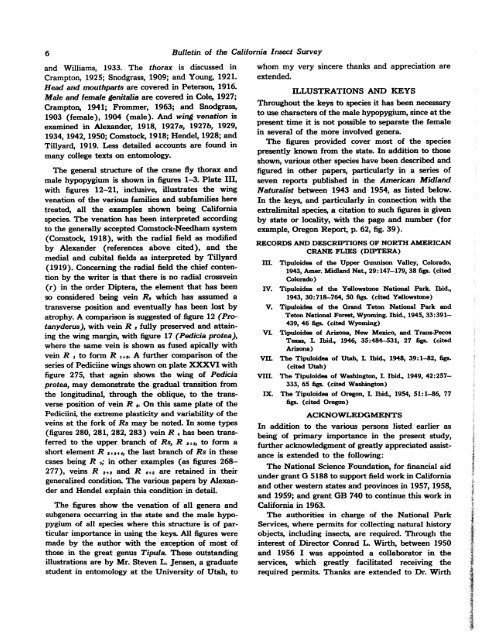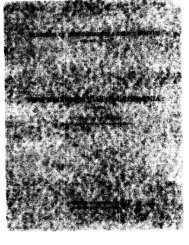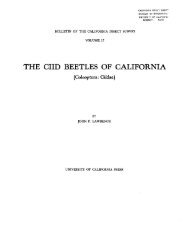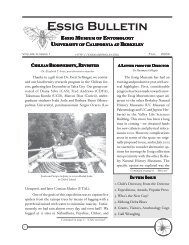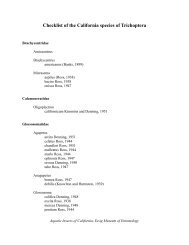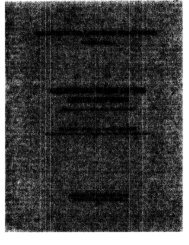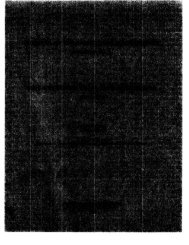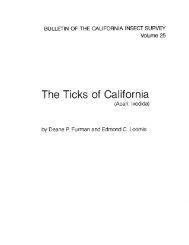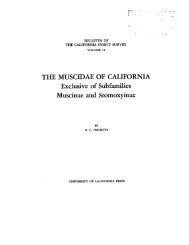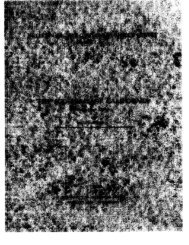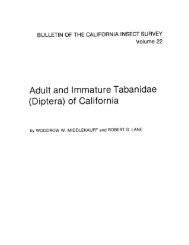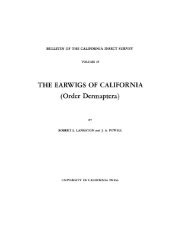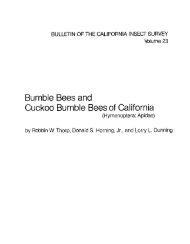The Crane Flies of California - Essig Museum of Entomology ...
The Crane Flies of California - Essig Museum of Entomology ...
The Crane Flies of California - Essig Museum of Entomology ...
You also want an ePaper? Increase the reach of your titles
YUMPU automatically turns print PDFs into web optimized ePapers that Google loves.
6 Bulletin <strong>of</strong> the <strong>California</strong> Znsect Survey<br />
and Williams, 1933. <strong>The</strong> thorax is discussed in<br />
Crampton, 1925; Snodgrass, 1909; and Young, 1921.<br />
Head and mouthparts are covered in Peterson, 1916.<br />
Male and female genitalia are covered in Cole, 1927;<br />
Crampton, 1941; Fromer, 1963; and Snodgrass,<br />
1903 (female), 1904 (male). And wing venation is<br />
examined in Alexander, 1918, 1927a, 1927b, 1929,<br />
1934, 1942,1950; Cornstock, 1918; Hendel, 1928; and<br />
Tillyard, 1919. Less detailed accounts are found in<br />
many college texts on entomology.<br />
<strong>The</strong> general structure <strong>of</strong> the crane fly thorax and<br />
male hypopygium is shown in figures 1-3. Plate 111,<br />
with figures 12-21, inclusive, illustrates the wing<br />
venation <strong>of</strong> the various families and subfamilies here<br />
treated, all the examples shown being <strong>California</strong><br />
species. <strong>The</strong> venation has been interpreted according<br />
to the generally accepted Comstock-Needham system<br />
(Cornstock, 1918), with the radial field as modified<br />
by Alexander (references above cited), and the<br />
medial and cubital fields as interpreted by Tillyard<br />
(1919). Concerning the radial field the chief contention<br />
by the writer is that there is no radial crossvein<br />
(r) in the order Diptera, the element that has been<br />
so considered being vein Rp which has assumed a<br />
transverse position and eventually has been lost by<br />
atrophy. A comparison is suggested <strong>of</strong> figure 12 (Protanyderus),<br />
with vein R p fully preserved and attaining<br />
the wing margin, with figure 17 (Pedicia protea),<br />
where the same vein is shown as fused apically with<br />
vein R to form R I+s. A further comparison <strong>of</strong> the<br />
series <strong>of</strong> Pediciine wings shown on plate XXXVI with<br />
figure 275, that again shows the wing <strong>of</strong> Pedicia<br />
protea, may demonstrate the gradual transition from<br />
the longitudinal, through the oblique, to the transverse<br />
position <strong>of</strong> vein R p. On this same plate <strong>of</strong> the<br />
Pediciini, the extreme plasticity and variability <strong>of</strong> the<br />
veins at the fork <strong>of</strong> Rs may be noted. In some types<br />
(figures 280, 281, 282, 283) vein R has been transferred<br />
to the upper branch <strong>of</strong> Rs, R to form a<br />
short element R 2+s+4, the last branch <strong>of</strong> Rs in these<br />
cases being R s; in other examples (as figures 268-<br />
277), veins R I+s and R 1+5 are retained in their<br />
generalized condition. <strong>The</strong> various papers by Alexander<br />
and Hendel explain this condition in detail.<br />
<strong>The</strong> figures show the venation <strong>of</strong> all genera and<br />
subgenera occurring in the state and the male hypopygium<br />
<strong>of</strong> all species where this structure is <strong>of</strong> particular<br />
importance in using the keys. All figures were<br />
made by the author with the exception <strong>of</strong> most <strong>of</strong><br />
those in the great genus Tipda. <strong>The</strong>se outstanding<br />
illustrations are by Mr. Steven L. Jensen, a graduate<br />
student in entomology at the University <strong>of</strong> Utah, to<br />
whom my very sincere thanks and appreciation are<br />
extended.<br />
ILLUSTRATIONS AND KEYS<br />
Throughout the keys to species it has been necessary<br />
to use characters <strong>of</strong> the male hypopygium, since at the<br />
present time it is not possible to separate the female<br />
in several <strong>of</strong> the more involved genera<br />
<strong>The</strong> figures provided cover most <strong>of</strong> the species<br />
presently known from the state. In addition to those<br />
shown, various other species have been described and<br />
figured in other papers, particularly in a series <strong>of</strong><br />
seven reports published in the American Midland<br />
Naturalist between 1943 and 1954, as listed below.<br />
In the keys, and particularly in connection with the<br />
extralimital species, a citation to such figures is given<br />
by state or locality, with the page and number (for<br />
example, Oregon Report, p. 62, fig. 39).<br />
RECORDS ANJ3 DESCRIPTIONS OF NORTH AMERICAN<br />
CRANE FLIES (DIPTERA)<br />
III.<br />
Tipdoidea <strong>of</strong> the Upper Gunnison Valley, Colorado,<br />
1943, her. Midland Nat, 29:147-179,38 figs. (cited<br />
ColOXXldO)<br />
IV. Tipdoidea <strong>of</strong> the Yellowstone National Park. Ibid,<br />
1943, 30:718-764, 50 figs. (cited Yellowstone)<br />
V. Tipdoidea <strong>of</strong> the Grand Teton National Park and<br />
Teton National Forest, Wyoming. Ibid., 1945,33:391-<br />
VL<br />
439, 46 6gs. (cited Wyoming)<br />
Tipuloidee <strong>of</strong> Arizona, New Mexico,and Trans-Pecos<br />
Taras, I. Ibid., 1946, 354844531, 27 figs. (cited<br />
-1<br />
VIL <strong>The</strong> Tipdoidea <strong>of</strong> Utah, I. Ibid., 1948, 39:1-82, figs.<br />
(cited Utah)<br />
MI. <strong>The</strong> Tipdoidea <strong>of</strong> Washington, I. Ibid., 1949, 42:257-<br />
333, 65 6gs. (cited Washington)<br />
IX. <strong>The</strong> Tipdoidea <strong>of</strong> Oregon, I. Ibid., 1954, 51:1-86, 77<br />
*.(cited On?Pon)<br />
ACKNOWLEDGMENTS<br />
In addition to the various persons listed earlier as<br />
being <strong>of</strong> primary importance in the present study,<br />
further acknowledgment <strong>of</strong> greatly appreciated assistance<br />
is extended to the following:<br />
<strong>The</strong> National Science Foundation, for financial aid<br />
under grant G 5188 to support field work in <strong>California</strong><br />
and other western states and provinces in 1957, 1958,<br />
and 1959; and grant GB 740 to continue this work in<br />
<strong>California</strong> in 1963.<br />
<strong>The</strong> authorities in charge <strong>of</strong> the National Park<br />
Services, where permits for collecting natural history<br />
objects, including insects, are required. Through the<br />
interest <strong>of</strong> Director Conrad L. Wirth, between 1950<br />
and 1956 I was appointed a collaborator in the<br />
services, which greatly facilitated receiving the<br />
required permits. Thanks are extended to Dr. Wirth


